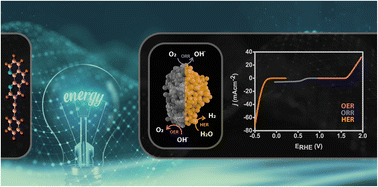Exploration of cobalt(ii) modification in a phenanthroline-based conjugated organic polymer towards trifunctional electrocatalysis†
Abstract
A redox-active donor–acceptor pair conjugated organic polymer (COP), TBB-phen, was synthesized via tetrakis(triphenylphosphine)palladium-catalyzed Sonogashira-coupling. It was modified further by stabilizing cobalt(II) into the organic polymer to create Co@TBB-phen. At room temperature, the polymers exhibited substantial charge separation, semiconducting behavior, and an embedded spherical morphology. Multi-point Brunauer–Emmett–Teller analysis revealed adequate surface area and mesoporosity (d = 2.7 nm). TBB-phen was explored for electrocatalysis, where it showed good oxygen reduction activity with a low onset potential of 0.78 V (vs. reversible hydrogen electrode) and low overpotential (332 mV@10 mA cm−2) towards the hydrogen evolution reaction (HER). However, Co@TBB-phen could deliver the oxygen evolution reaction (OER) along with amelioration of the oxygen reduction reaction (ORR) and HER. The overpotential for the ORR and HER was reduced by 30 mV and 33 mV, respectively, with oxygen evolution at 560 mV@10 mA cm−2. A study on natural bond orbitals revealed charge transfer and orbital interactions that confirmed the effective utilization of π-conjugation in the ORR and OER. Density functional theory (DFT) computations in the OER and HER provided a plausible reaction mechanism and descriptors, along with affirming that the designed polymer was an impeccable donor–acceptor pair. This work opens a door for phenanthroline molecules in electrochemical-energy applications.



 Please wait while we load your content...
Please wait while we load your content...